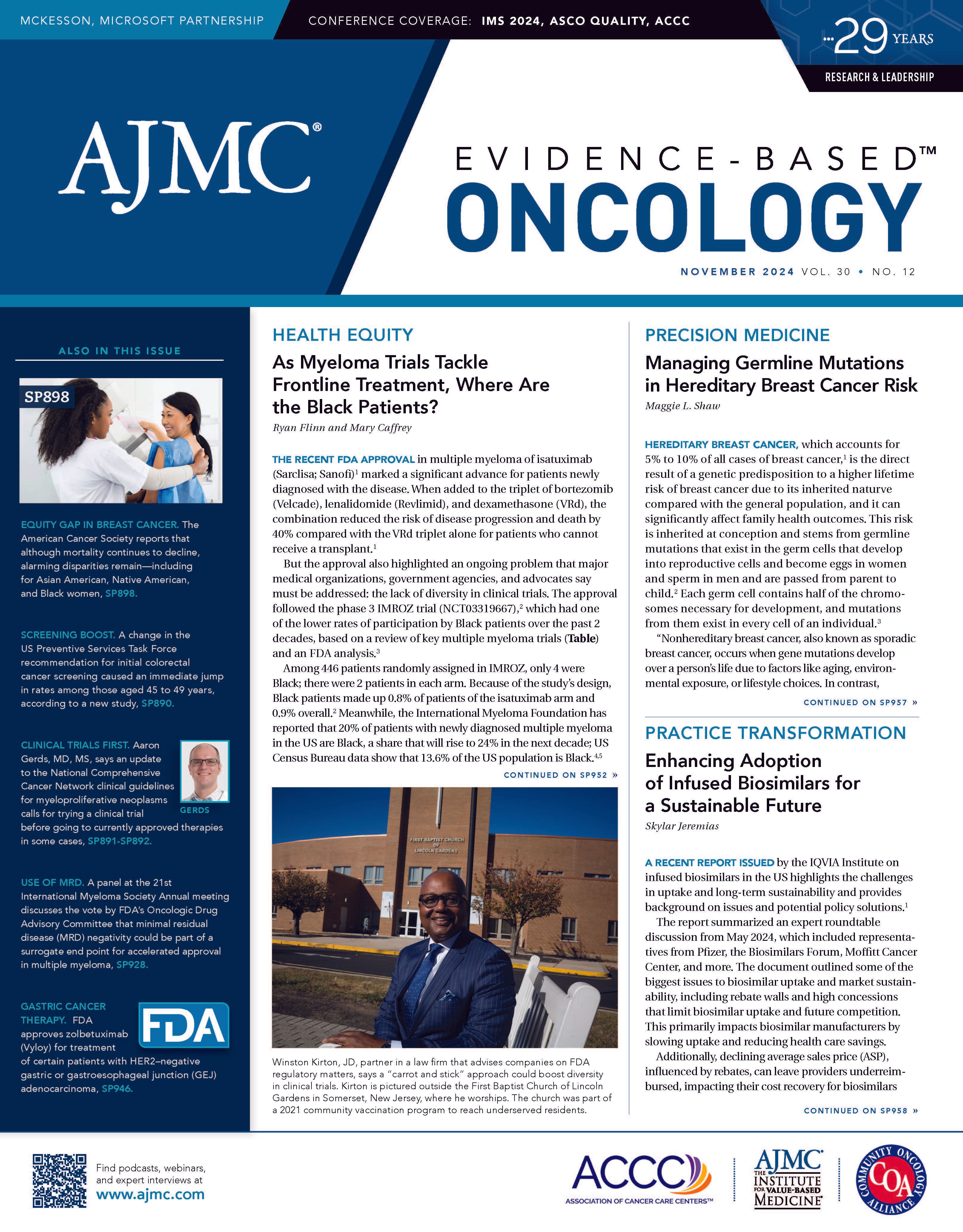- Center on Health Equity & Access
- Clinical
- Health Care Cost
- Health Care Delivery
- Insurance
- Policy
- Technology
- Value-Based Care
Innovating Cancer Care Through Equity and AI: Vanderbilt’s Vision
Coverage from the IVBM event with Vanderbilt-Ingram Cancer Center in Nashville, Tennessee.
Innovating cancer care and strengthening community relationships through equity initiatives that address disparities and prioritize collaboration and advocacy were the highlight of an Institute for Value-Based Management event held in Nashville, Tennessee, in October. The event featured experts from Vanderbilt-Ingram Cancer Center, and the theme was “Bringing the Future to the Present in Cancer Care.
Cathy Eng, MD, FACP, FASCO | Image: Vanderbilt-Ingram Cancer Center
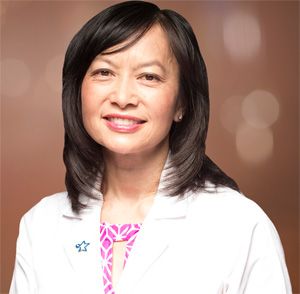
Jordan Berlin, MD, FASCO | Image: Vanderbilt-Ingram Cancer Center
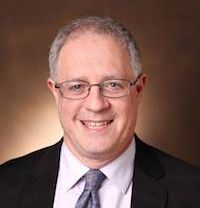
The cochairs were Cathy Eng, MD, FACP, FASCO, the David H. Johnson Endowed Chair in Surgical and Medical Oncology and professor of medicine, hematology, and oncology; and Jordan Berlin, MD, FASCO, associate director for clinical research and director, Division of Hematology and Oncology.
They were joined by Keith Obstein, MD, MPH, FASGE, associate professor of medicine and of mechanical engineering and program director, gastroenterology fellowship; Kamran Idrees, MD, MSCI, MMHC, FACS, chief, Division of Surgical Oncology and Endocrine Surgery, and director of pancreatic and gastrointestinal surgical oncology; Travis Osterman, DO, MS, FAMIA, FASCO, associate vice president for research informatics, and director, cancer clinical informatics; and Karen Winkfield, MD, PhD, executive director, Meharry-Vanderbilt Alliance; associate director, Community Outreach and Engagement; and Ingram Professor of Cancer Research.
Presentations brought to life how cancer care is being shaped through incorporating predictive modeling for immunotherapy response and employing artificial intelligence (AI) in both endoscopy for colon cancer and histotripsy for liver cancer, confirming the redirection of value-based cancer care through personalized data-driven approaches. And the focus on equity, collaboration, and expanding care access underscores why not just the field of oncology but health care overall needs to ensure these newest advances reach diverse populations in underserved communities, address systemic disparities, and transform patient outcomes.
Through the Looking Glass: Predicting the Future of Colonoscopy
“If we’re going to talk about the future and predicting it, we have to go back to the past,” Obstein said, as he kicked off the evening with an at-times humorous but insightful address on the evolution and future of colonoscopy.
Keith Obstein, MD, MPH, FASGE | Image: Vanderbilt-Ingram Cancer Center
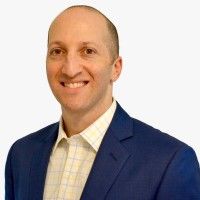
He provided an overview of how far colonoscopy has come, spurred, he emphasized, by great minds not afraid to innovate and use blue-sky thinking, or free-range brainstorming.1 He noted the span from the invention of the Lichtleiter in 1806,2 the first lighted device used to internally inspect the human body, to the live television broadcast of Katie Couric’s March 2000 colonoscopy, which saw a significant jump in numbers of the procedure and would come to be known as “The Couric Effect.”3
Technological advances are revolutionizing both patient care and procedure efficiency, with there now being more than 100 different flexible endoscopes, Obstein noted. With specialized scopes, it’s possible to record images and leverage AI to enhance diagnostics, such as assisting in detecting and diagnosing potential polyps and streamlining the decision-making process.
Likely gone are the days of having to just rely on human interpretation, he said. Another pioneering development was locomotion, a procedure that uses a pneumatically driven robotic disposable colonoscope4 to improve colon navigation and that aims to increase the detection and removal of cancerous polyps through greater precision and safety.
Obstein also discussed the significant impact of medical waste on the environment and how those in his field are exploring potential solutions. These include implementing the cautious use of disposable endoscopes, transitioning to recycling certain components, adapting current endoscopes for multiple uses, and fitting them with add-on features to increase efficiency.
“So rather than buying 100-plus endoscopes, including 10 specialty scopes and 20 additional scopes that have ultrasound,” he posed, “what about converting our forward-viewing endoscopes into linear array echo endoscopes by putting an add-on piece to gain more value per unit or increase dexterity?”
As for transforming access to colonoscopies, Obstein emphasized that there is a great need for more mobile endoscopy services to increase colon cancer screenings and reduce health care disparities in underserved communities and for enhanced telemedicine capabilities that could permit real-time collaboration with experts around the world. Improving training efficiency for gastroenterologists is another path to progress, with haptic technology, or tactile feedback that helps to simulate touch,5 as is redesigning endoscopes to be more user friendly, he said.
“I think the future is bright,” he concluded. “I think it’s developing rapidly as we increase our firepower in terms of computers, technology, and just innovative designs and thinking outside the box.”
Histotripsy and Its Role in Treating Liver Tumors
“We have purchased the machine that does this new procedure,” Eng said when introducing Idrees, “and we’re hoping it’s going to change the field of cancer regarding liver metastasis.”
Histotripsy is a newer innovative procedure in which high-intensity sound waves, sent in small pulses of less than 20 microseconds, target and work to destroy liver tumors without damaging surrounding healthy tissue.6 The noninvasive treatment was approved by the FDA in 2023 for treating patients with liver cancer.7 Key strength of the procedure is its ability to achieve sharp, clear margins around the tumor; it presents an additional option for patients who are not surgical candidates. Data from 44 patients with hepatocellular carcinoma or metastatic liver tumors in the #HOPE4LIVER US trial supported the approval; the trial had a 97% technical success rate,8 and adverse events were seen in only 3 patients.9
In contrast to more traditional thermal ablation techniques—with which there is a greater risk of incomplete tumor destruction—the microscopic bubbles created by histotripsy help to preserve vital structures, Idrees explained. After a patient has been placed under general anesthesia, he said, a clinician uses an ultrasound to pinpoint a tumor, and this helps to direct the histotripsy machine’s ultrasound waves to liquefy the cancerous tissue. For most patients, this is a same-day procedure and there are no significant complications; each lesion can take between 13 and 20 minutes to dissolve, and the current limit for each procedure is 3 to 5 lesions.
“The best part about it is tissue selectivity. It affects the tumor cells, and it affects the normal liver tissue, but it doesn’t affect the key structures within the liver,” Idrees said. “So anything that has collagen in it, like the blood vessels and the bile ducts that we want to preserve, it completely preserves them.”
Next steps in advancing histotripsy include further evaluating what may be an immune response following the procedure, with there being several observations of untreated liver tumors shrinking post histotripsy treatment, Idrees said, “indicating a possible abscopal effect.” He also broached the possibility of using a patient’s immune system through histotripsy to fight colorectal metastases, since most patients he sees are ineligible for immunotherapy or don’t benefit from it. He also highlighted how this technology is currently being investigated in several other cancer types, including renal cell tumors.
Leveraging AI to Deliver Precision Immunotherapy
“Our amazing informatician” is how Berlin introduced Osterman to deliver the evening’s third presentation, which examined the need to consider treatment toxicity while seeking treatment efficiency.
Travis Osterman, DO, MS, FAMIA, FASCO | Image: Vanderbilt-Ingram Cancer Center
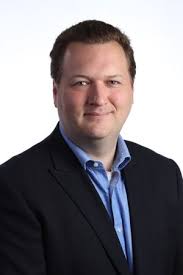
He started with contrasting case studies of 2 patients with stage IV non–small cell lung cancer and their markedly different responses to immunotherapy, despite both having high PD-L1 expression and low disease burden. The first patient treated with pembrolizumab (Keytruda) in 2014 developed colitis but achieved long-term remission; the second patient, who was treated in 2016 with ipilimumab (Yervoy) and nivolumab (Opdivo), developed severe pneumonitis and died following disease progression.
“One of the challenges, I think, for many of us who use these drugs is, I never want to miss someone who could be that first patient. I never want to miss the opportunity to give a patient immunotherapy,” Osterman said. “But I’m also tempered by how bad some of the adverse effects can be for certain patients,” which highlights the importance of careful patient selection in immunotherapy.
He discussed his work with GE HealthCare and Vanderbilt’s partnership on the Digital Precision Oncology Project. In a discussion with The American Journal of Managed Care® (AJMC), Osterman explained that the collaboration began 5 years ago, with the aim of using routinely collected clinical data on patients with cancer to predict immunotherapy toxicity. The partnership wanted to “see if we could learn from those data which patients were likely to have toxicities from immunotherapy and which patients were likely to have disproportional benefits to immunotherapy, with the goal of ultimately helping oncologists and their patients make better and more informed decisions about their treatment options. Just about every approach to predicting this question of toxicities and efficacy to immunotherapy has been attempted,” he said.
The project’s pan-tumor sample—meaning many cancer types were represented—of approximately 2700 patients is one of the larger samples
for this type of project in the US, he explained, and it used 4 models trained on approximately 2000 patients each. Using data sets as prediction tools can present logistical issues such as small sample sizes and a lack of external validation, which is why the partnership chose to focus on data that were already being collected at Vanderbilt, “so that if we’re able to show a signal, we’ll be able to disseminate this in a very widespread way,” he said
Clinical utility was also a focus, in that another goal of the data evaluation was to not just know there would be adverse effects but to explain why different patients had different reactions and to provide that feedback to clinicians and those patients. “I don’t need a computer algorithm to tell me that a patient is at high risk of having an adverse effect from a disease,” Osterman explained to AJMC. “What I need the algorithm to tell me is how is this different than the average patient.”
Such predictive modeling can advance patient care on the basis of informed discussion and agreement between a patient and their clinician using the best-prevailing evidence to understand treatment outcomes, Osterman has written.10
A Vision for Community Outreach and Engagement in Nashville and Beyond
“Because every community has a reality in the US, we have to learn how to meet people where they are. People think that it requires a whole lot of effort, and it doesn’t,” Winkfield told AJMC. “For my physician colleagues, even just kind of thinking about your daily practice and how you engage with people, having that culture, humility, the willingness to ask those questions, is really important.”
Karen Winkfield, MD, PhD | Image: Vanderbilt-Ingram Cancer Center
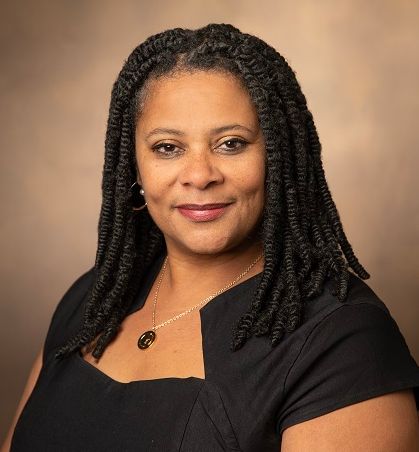
She brought the evening to a close by addressing the challenges inherent in translating groundbreaking research into community impact. She emphasized the necessity of helping communities answer the question of how the research will affect them and whether they will have access to the newest innovations, and noted that not all populations have equal, or equitable, access to every breakthrough.
“It’s important to think about how we actually represent ourselves in the community. We can have such a huge impact, even if we just did 1 talk a year around cancer screening or the advances that are being made,” she told AJMC. “This is important to help educate our community, but also to engage them because then we get to be seen as a trusted partner.”
The populations at greatest risk of adverse health outcomes and higher cancer mortality rates because of these health care access disparities are racial and ethnic minorities, adolescent and young adults, older adults, LGBTQ+ and sexual and gender minorities, the differently abled, immigrants and refugees, and underinsured and uninsured communities, as well as persons who live in a rural vs and urban location, she said.
Principal challenges that medically underserved communities more often face can be traced back to political determinants, such as federal and state laws and regulations; social determinants that include living and working conditions, systemic and structural racism, agriculture and food, unemployment, poverty, and housing; unmet social needs; and internalized drivers she said.
There remains a great need for actionable frameworks built around community engagement, patient navigation, data collection, health equity, funding support, education and training, and clinical trials that take patients from that initial screen through diagnosis, treatment, and survivorship. For the Vanderbilt-Ingram Cancer Center Office of Community and Engagement, this means reducing the cancer burden and disparities within their immediate catchment area and beyond by assessing and prioritizing cancer-related needs and opportunities in those locations; informing and facilitating basic, clinical, and population research in response to cancer-related needs and community priorities; and implementing and disseminating evidence-based cancer prevention, control, and care, Winkfield said.
In 2023, the Vanderbilt-Ingram Cancer Center Office of Community and Engagement held more than 300 events, 175 of which were education programs, and reached more than 20,000 people—a number that has quadrupled since 2017—through initiatives targeting a population comprised of 23% Latino individuals, 19% Black/African American individuals, and 17% rural dwellers.
For the Meharry-Vanderbilt Alliance team, this means developing and supporting partnerships among Meharry Medical College, Vanderbilt University Medical Center, and their communities through “purposeful support of health equity and health care access for all.” It also includes providing training and mentoring opportunities for faculty and trainees, and expertise in community engagement.
This being an election year, Winkfield said it’s imperative to be policy advocates for systems-level change, to really think about what are the important drivers, and from a policy perspective consider what can be done to make sure that people in underserved communities have access to care.
“You have to be intentional about the way you do engagement. It’s not just about slapping brochures or fliers up,” Winkfield said. “You have to have a plan, you have to do assessments, you have to prioritize.”
References
1. Generate a cascade of ideas with blue sky thinking. Ideanote. July 4, 2023. Accessed October 21, 2024. https://ideanote.io/blog/blue-sky-thinking
2. The Bozzini endoscope. American College of Surgeons. Accessed October 21, 2024. https://www.facs.org/about-acs/archives/past-highlights/bozzinihighlight/
3. Katie Couric’s cancer journey: from grief to advocacy to her own breast cancer diagnosis. Memorial Sloan Kettering Cancer Center. Accessed October 21, 2024. https://www.mskcc.org/videos/katie-couric-cancer-journey-grief-advocacy-her-own-breast-cancer-diagnosis#:~:text=Jay%20Monahan%20was%20diagnosed%20with,known%20as%20the%20Couric%20Effect
4. Ahmed JF, Franco E, Baena FRY, Darzi A, Patel N. A review of bioinspired locomotion in lower GI endoscopy. Robotica. Published online January 22, 2024. Accessed October 22, 2024. https://www.cambridge.org/core/journals/robotica/article/review-of-bioinspired-locomotion-in-lower-gi-endoscopy/CC08EEBB1A0616FF08B0C17B908B838E
5. Haptic technology: the future of engagement? Mass Challenge. September 23, 2021. Accessed October 22, 2024. https://masschallenge.org/articles/haptic-technology/
6. Treating liver tumors with sound waves. UChicago Medicine. Accessed October 21, 2024. https://www.uchicagomedicine.org/cancer/types-treatments/histotripsy
7. Lynch J. FDA approves histotripsy for liver treatment in humans. News release. University of Michigan. October 9, 2023. Accessed October 22, 2024. https://record.umich.edu/articles/fda-approves-histotripsy-for-liver-treatment-in-humans/
8. The HistoSonics System for treatment of primary and metastatic liver tumors using histotripsy (#HOPE4LIVER US). ClinicalTrials.gov. Updated October 10, 2024. Accessed October 22, 2024. https://clinicaltrials.gov/study/NCT04572633
9. Liver cancer program among the first in the country to offer noninvasive histotripsy for destroying cancerous liver tumors. NewYork-Presbyterian. June 3, 2024. Accessed October 22, 2024. https://www.nyp.org/advances/article/liver-cancer-program-among-the-first-in-the-country-to-offer-noninvasive-histotripsy-for-destroying-cancerous-liver-tumors
10. Lippenszky L, Mittendorf KF, Kiss Z, et al. Prediction of effectiveness and toxicities of immune checkpoint inhibitors using real-world patient data. JCO Clin Cancer Inform. 2024;8 https://doi.org/10.1200/CCI.23.00207
